Comprehensive Analysis of Standard Costing and Variance
VerifiedAdded on 2019/09/23
|11
|2810
|181
Report
AI Summary
This report provides a comprehensive overview of standard costing and variance analysis, crucial concepts in finance and cost accounting. It defines standard costs as predetermined costs based on efficient operation standards and explores the importance of variance analysis in identifying deviations between actual and standard costs. The report details various types of standards, including ideal, normal, basic, and current standards, and discusses their applications. It outlines the standard costing process, encompassing setting standards, ascertaining actual costs, and analyzing variances. The report further delves into the advantages of standard costing, such as aiding in cost control, pricing decisions, and performance evaluation. It also addresses criticisms of standard costing. The report then examines variance analysis, including cost variance analysis, and the calculation of material, labor, and overhead variances. The report concludes by highlighting the importance of variance investigation and corrective actions to improve cost efficiency.
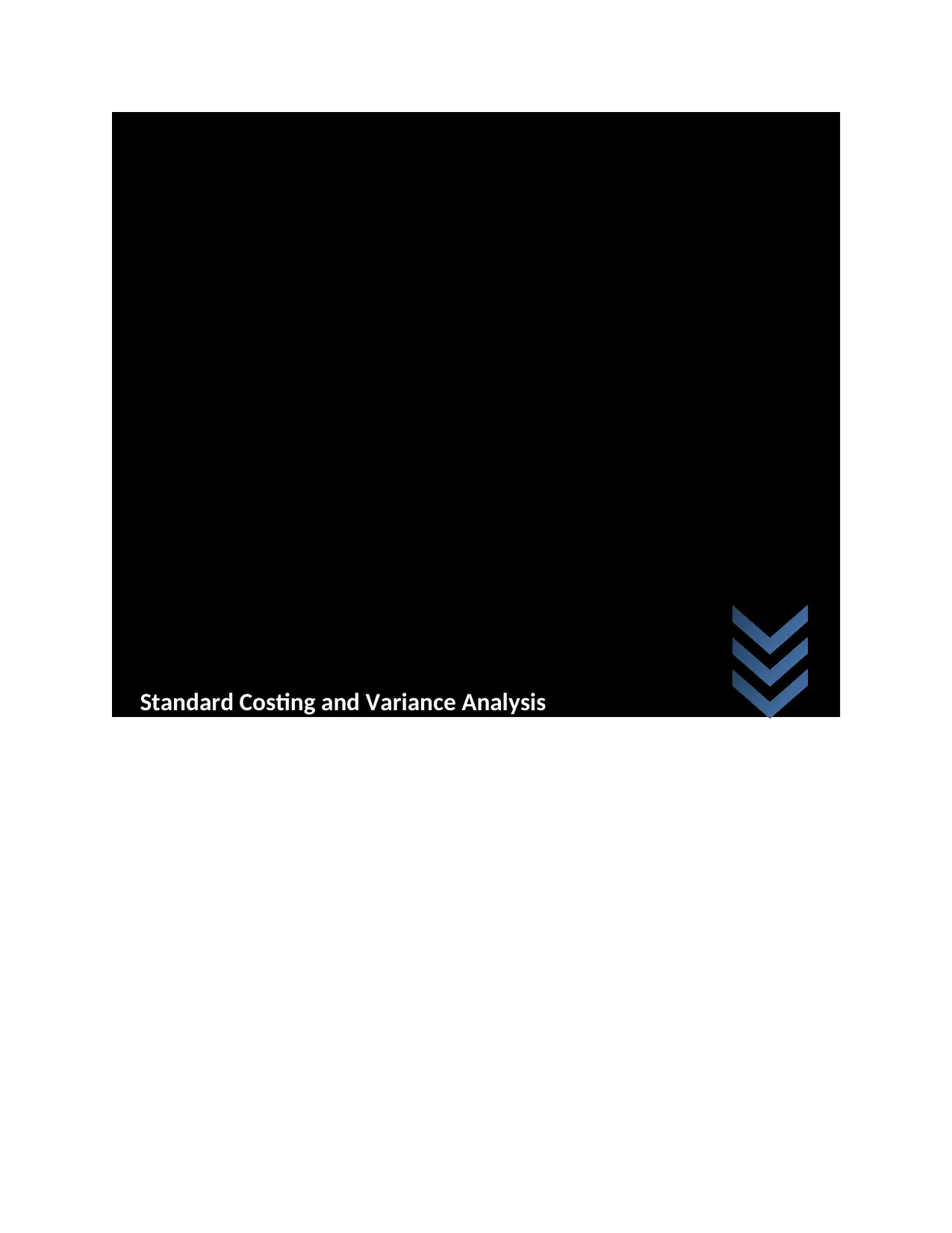
Standard Costing and Variance Analysis
Paraphrase This Document
Need a fresh take? Get an instant paraphrase of this document with our AI Paraphraser
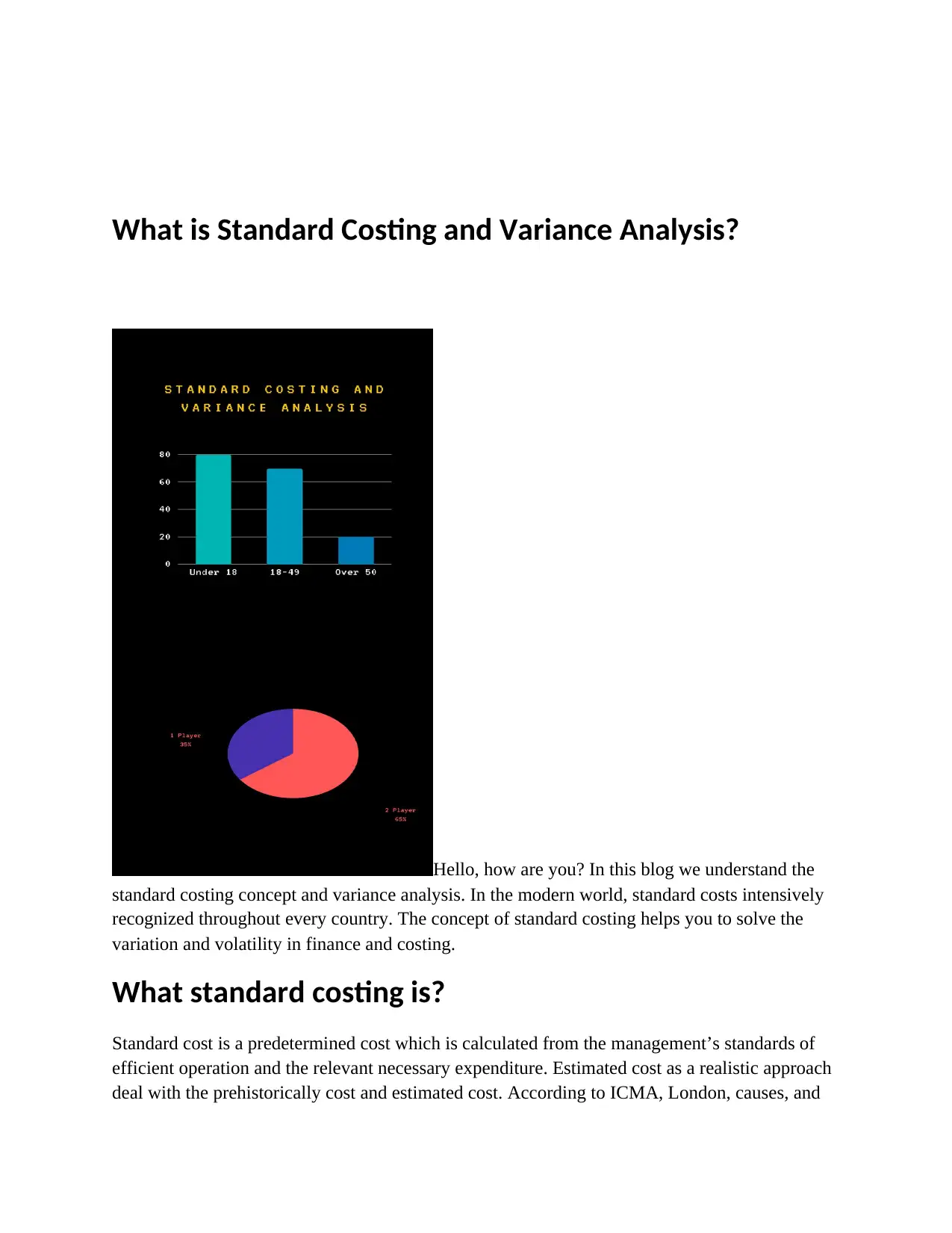
What is Standard Costing and Variance Analysis?
Hello, how are you? In this blog we understand the
standard costing concept and variance analysis. In the modern world, standard costs intensively
recognized throughout every country. The concept of standard costing helps you to solve the
variation and volatility in finance and costing.
What standard costing is?
Standard cost is a predetermined cost which is calculated from the management’s standards of
efficient operation and the relevant necessary expenditure. Estimated cost as a realistic approach
deal with the prehistorically cost and estimated cost. According to ICMA, London, causes, and
Hello, how are you? In this blog we understand the
standard costing concept and variance analysis. In the modern world, standard costs intensively
recognized throughout every country. The concept of standard costing helps you to solve the
variation and volatility in finance and costing.
What standard costing is?
Standard cost is a predetermined cost which is calculated from the management’s standards of
efficient operation and the relevant necessary expenditure. Estimated cost as a realistic approach
deal with the prehistorically cost and estimated cost. According to ICMA, London, causes, and
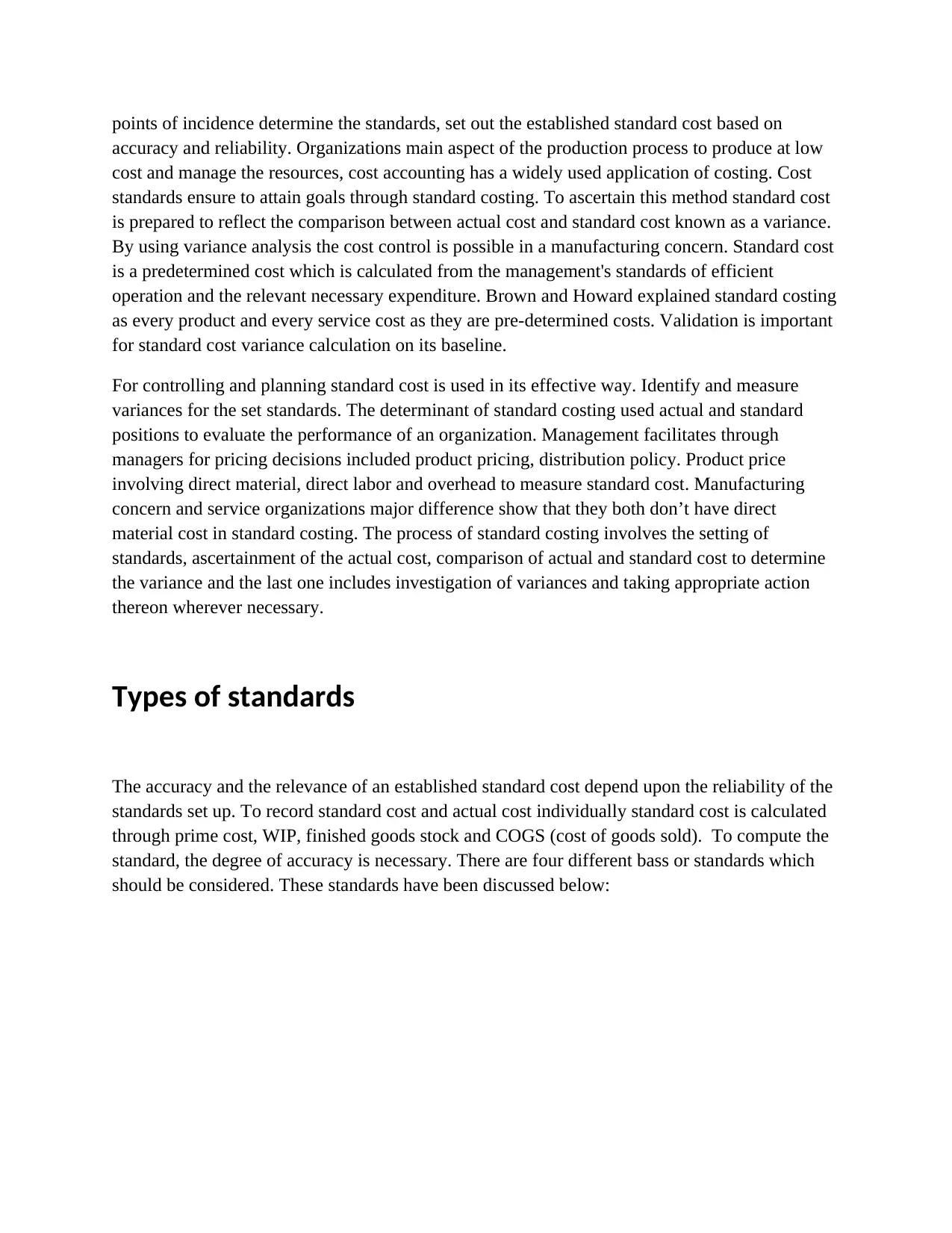
points of incidence determine the standards, set out the established standard cost based on
accuracy and reliability. Organizations main aspect of the production process to produce at low
cost and manage the resources, cost accounting has a widely used application of costing. Cost
standards ensure to attain goals through standard costing. To ascertain this method standard cost
is prepared to reflect the comparison between actual cost and standard cost known as a variance.
By using variance analysis the cost control is possible in a manufacturing concern. Standard cost
is a predetermined cost which is calculated from the management's standards of efficient
operation and the relevant necessary expenditure. Brown and Howard explained standard costing
as every product and every service cost as they are pre-determined costs. Validation is important
for standard cost variance calculation on its baseline.
For controlling and planning standard cost is used in its effective way. Identify and measure
variances for the set standards. The determinant of standard costing used actual and standard
positions to evaluate the performance of an organization. Management facilitates through
managers for pricing decisions included product pricing, distribution policy. Product price
involving direct material, direct labor and overhead to measure standard cost. Manufacturing
concern and service organizations major difference show that they both don’t have direct
material cost in standard costing. The process of standard costing involves the setting of
standards, ascertainment of the actual cost, comparison of actual and standard cost to determine
the variance and the last one includes investigation of variances and taking appropriate action
thereon wherever necessary.
Types of standards
The accuracy and the relevance of an established standard cost depend upon the reliability of the
standards set up. To record standard cost and actual cost individually standard cost is calculated
through prime cost, WIP, finished goods stock and COGS (cost of goods sold). To compute the
standard, the degree of accuracy is necessary. There are four different bass or standards which
should be considered. These standards have been discussed below:
accuracy and reliability. Organizations main aspect of the production process to produce at low
cost and manage the resources, cost accounting has a widely used application of costing. Cost
standards ensure to attain goals through standard costing. To ascertain this method standard cost
is prepared to reflect the comparison between actual cost and standard cost known as a variance.
By using variance analysis the cost control is possible in a manufacturing concern. Standard cost
is a predetermined cost which is calculated from the management's standards of efficient
operation and the relevant necessary expenditure. Brown and Howard explained standard costing
as every product and every service cost as they are pre-determined costs. Validation is important
for standard cost variance calculation on its baseline.
For controlling and planning standard cost is used in its effective way. Identify and measure
variances for the set standards. The determinant of standard costing used actual and standard
positions to evaluate the performance of an organization. Management facilitates through
managers for pricing decisions included product pricing, distribution policy. Product price
involving direct material, direct labor and overhead to measure standard cost. Manufacturing
concern and service organizations major difference show that they both don’t have direct
material cost in standard costing. The process of standard costing involves the setting of
standards, ascertainment of the actual cost, comparison of actual and standard cost to determine
the variance and the last one includes investigation of variances and taking appropriate action
thereon wherever necessary.
Types of standards
The accuracy and the relevance of an established standard cost depend upon the reliability of the
standards set up. To record standard cost and actual cost individually standard cost is calculated
through prime cost, WIP, finished goods stock and COGS (cost of goods sold). To compute the
standard, the degree of accuracy is necessary. There are four different bass or standards which
should be considered. These standards have been discussed below:
⊘ This is a preview!⊘
Do you want full access?
Subscribe today to unlock all pages.

Trusted by 1+ million students worldwide

Ideal standards: This standard represents the level of performance attainable when prices are
made for material and labor are most favorable, when the highest output is achieved with the best
equipment and layout and when the maximum efficiency in utilization of resources utilized in
maximum output with minimum cost. The types of standards are criticized on three grounds:
1. Since such standards would be attainable, no one would take them seriously
2. The variances disclosed would be variances from ideal standards. These would not, therefore,
indicate the extent to which they could have been reasonably and practically avoided.
3. There would be no logic method of disposing of these variance
Normal standards: These standards may be achieved under normal operating conditions. The
normal activity has been defined as ‘' the number of standard hours which will produce at normal
efficiency sufficient goods to meet the average sales demand over a term of years. These
standards are difficult to set because they require a degree of forecasting.
made for material and labor are most favorable, when the highest output is achieved with the best
equipment and layout and when the maximum efficiency in utilization of resources utilized in
maximum output with minimum cost. The types of standards are criticized on three grounds:
1. Since such standards would be attainable, no one would take them seriously
2. The variances disclosed would be variances from ideal standards. These would not, therefore,
indicate the extent to which they could have been reasonably and practically avoided.
3. There would be no logic method of disposing of these variance
Normal standards: These standards may be achieved under normal operating conditions. The
normal activity has been defined as ‘' the number of standard hours which will produce at normal
efficiency sufficient goods to meet the average sales demand over a term of years. These
standards are difficult to set because they require a degree of forecasting.
Paraphrase This Document
Need a fresh take? Get an instant paraphrase of this document with our AI Paraphraser
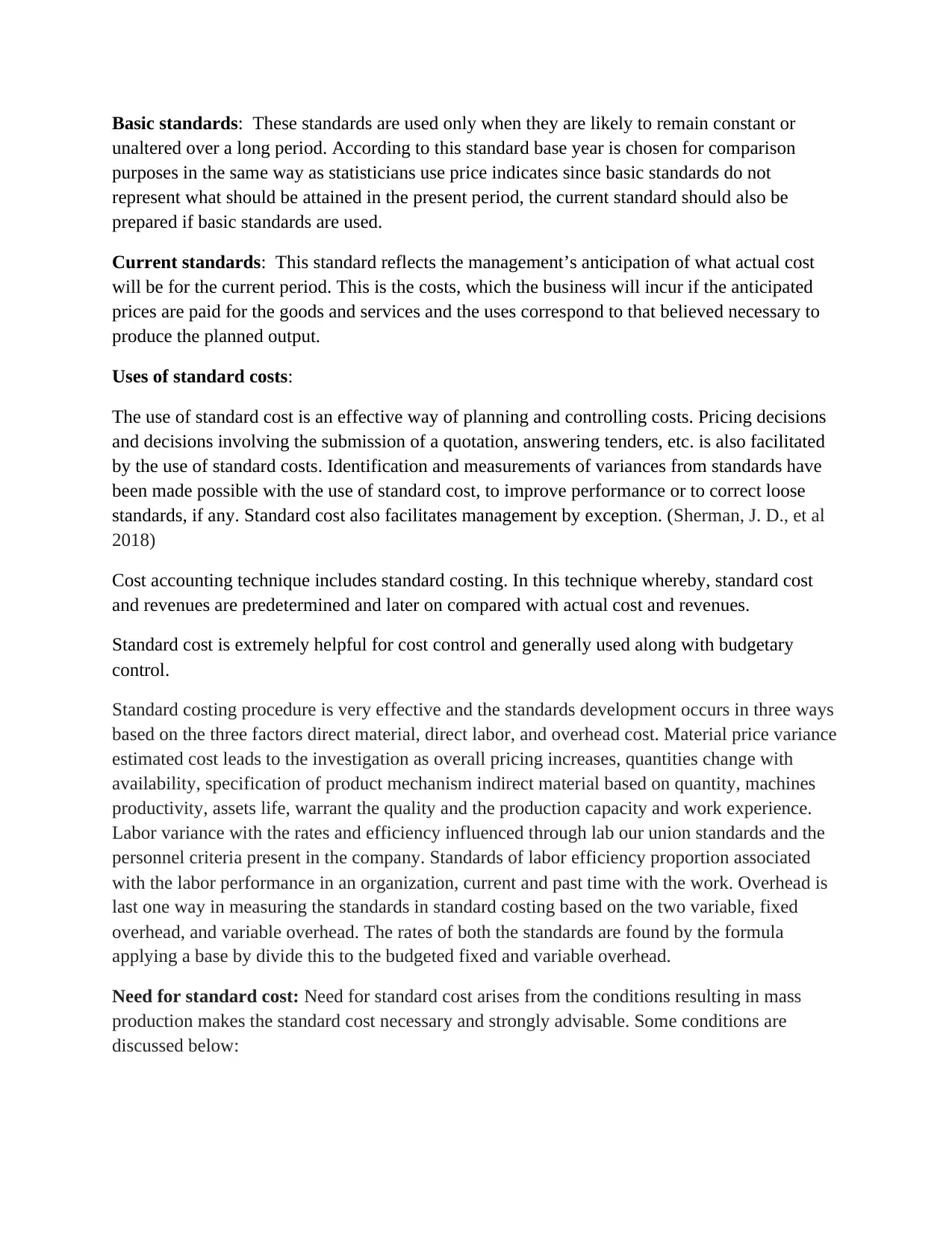
Basic standards: These standards are used only when they are likely to remain constant or
unaltered over a long period. According to this standard base year is chosen for comparison
purposes in the same way as statisticians use price indicates since basic standards do not
represent what should be attained in the present period, the current standard should also be
prepared if basic standards are used.
Current standards: This standard reflects the management’s anticipation of what actual cost
will be for the current period. This is the costs, which the business will incur if the anticipated
prices are paid for the goods and services and the uses correspond to that believed necessary to
produce the planned output.
Uses of standard costs:
The use of standard cost is an effective way of planning and controlling costs. Pricing decisions
and decisions involving the submission of a quotation, answering tenders, etc. is also facilitated
by the use of standard costs. Identification and measurements of variances from standards have
been made possible with the use of standard cost, to improve performance or to correct loose
standards, if any. Standard cost also facilitates management by exception. (Sherman, J. D., et al
2018)
Cost accounting technique includes standard costing. In this technique whereby, standard cost
and revenues are predetermined and later on compared with actual cost and revenues.
Standard cost is extremely helpful for cost control and generally used along with budgetary
control.
Standard costing procedure is very effective and the standards development occurs in three ways
based on the three factors direct material, direct labor, and overhead cost. Material price variance
estimated cost leads to the investigation as overall pricing increases, quantities change with
availability, specification of product mechanism indirect material based on quantity, machines
productivity, assets life, warrant the quality and the production capacity and work experience.
Labor variance with the rates and efficiency influenced through lab our union standards and the
personnel criteria present in the company. Standards of labor efficiency proportion associated
with the labor performance in an organization, current and past time with the work. Overhead is
last one way in measuring the standards in standard costing based on the two variable, fixed
overhead, and variable overhead. The rates of both the standards are found by the formula
applying a base by divide this to the budgeted fixed and variable overhead.
Need for standard cost: Need for standard cost arises from the conditions resulting in mass
production makes the standard cost necessary and strongly advisable. Some conditions are
discussed below:
unaltered over a long period. According to this standard base year is chosen for comparison
purposes in the same way as statisticians use price indicates since basic standards do not
represent what should be attained in the present period, the current standard should also be
prepared if basic standards are used.
Current standards: This standard reflects the management’s anticipation of what actual cost
will be for the current period. This is the costs, which the business will incur if the anticipated
prices are paid for the goods and services and the uses correspond to that believed necessary to
produce the planned output.
Uses of standard costs:
The use of standard cost is an effective way of planning and controlling costs. Pricing decisions
and decisions involving the submission of a quotation, answering tenders, etc. is also facilitated
by the use of standard costs. Identification and measurements of variances from standards have
been made possible with the use of standard cost, to improve performance or to correct loose
standards, if any. Standard cost also facilitates management by exception. (Sherman, J. D., et al
2018)
Cost accounting technique includes standard costing. In this technique whereby, standard cost
and revenues are predetermined and later on compared with actual cost and revenues.
Standard cost is extremely helpful for cost control and generally used along with budgetary
control.
Standard costing procedure is very effective and the standards development occurs in three ways
based on the three factors direct material, direct labor, and overhead cost. Material price variance
estimated cost leads to the investigation as overall pricing increases, quantities change with
availability, specification of product mechanism indirect material based on quantity, machines
productivity, assets life, warrant the quality and the production capacity and work experience.
Labor variance with the rates and efficiency influenced through lab our union standards and the
personnel criteria present in the company. Standards of labor efficiency proportion associated
with the labor performance in an organization, current and past time with the work. Overhead is
last one way in measuring the standards in standard costing based on the two variable, fixed
overhead, and variable overhead. The rates of both the standards are found by the formula
applying a base by divide this to the budgeted fixed and variable overhead.
Need for standard cost: Need for standard cost arises from the conditions resulting in mass
production makes the standard cost necessary and strongly advisable. Some conditions are
discussed below:
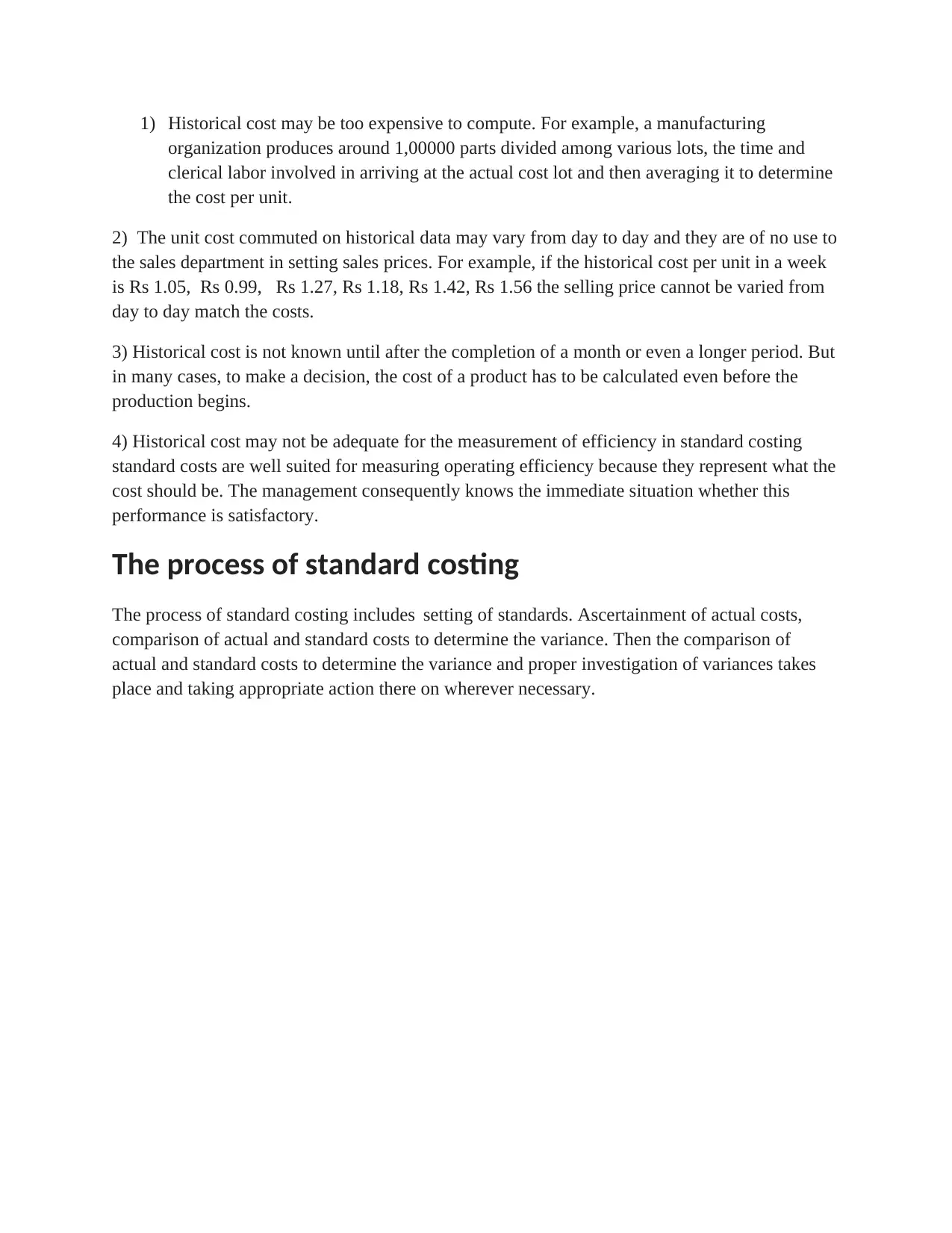
1) Historical cost may be too expensive to compute. For example, a manufacturing
organization produces around 1,00000 parts divided among various lots, the time and
clerical labor involved in arriving at the actual cost lot and then averaging it to determine
the cost per unit.
2) The unit cost commuted on historical data may vary from day to day and they are of no use to
the sales department in setting sales prices. For example, if the historical cost per unit in a week
is Rs 1.05, Rs 0.99, Rs 1.27, Rs 1.18, Rs 1.42, Rs 1.56 the selling price cannot be varied from
day to day match the costs.
3) Historical cost is not known until after the completion of a month or even a longer period. But
in many cases, to make a decision, the cost of a product has to be calculated even before the
production begins.
4) Historical cost may not be adequate for the measurement of efficiency in standard costing
standard costs are well suited for measuring operating efficiency because they represent what the
cost should be. The management consequently knows the immediate situation whether this
performance is satisfactory.
The process of standard costing
The process of standard costing includes setting of standards. Ascertainment of actual costs,
comparison of actual and standard costs to determine the variance. Then the comparison of
actual and standard costs to determine the variance and proper investigation of variances takes
place and taking appropriate action there on wherever necessary.
organization produces around 1,00000 parts divided among various lots, the time and
clerical labor involved in arriving at the actual cost lot and then averaging it to determine
the cost per unit.
2) The unit cost commuted on historical data may vary from day to day and they are of no use to
the sales department in setting sales prices. For example, if the historical cost per unit in a week
is Rs 1.05, Rs 0.99, Rs 1.27, Rs 1.18, Rs 1.42, Rs 1.56 the selling price cannot be varied from
day to day match the costs.
3) Historical cost is not known until after the completion of a month or even a longer period. But
in many cases, to make a decision, the cost of a product has to be calculated even before the
production begins.
4) Historical cost may not be adequate for the measurement of efficiency in standard costing
standard costs are well suited for measuring operating efficiency because they represent what the
cost should be. The management consequently knows the immediate situation whether this
performance is satisfactory.
The process of standard costing
The process of standard costing includes setting of standards. Ascertainment of actual costs,
comparison of actual and standard costs to determine the variance. Then the comparison of
actual and standard costs to determine the variance and proper investigation of variances takes
place and taking appropriate action there on wherever necessary.
⊘ This is a preview!⊘
Do you want full access?
Subscribe today to unlock all pages.

Trusted by 1+ million students worldwide

Paraphrase This Document
Need a fresh take? Get an instant paraphrase of this document with our AI Paraphraser
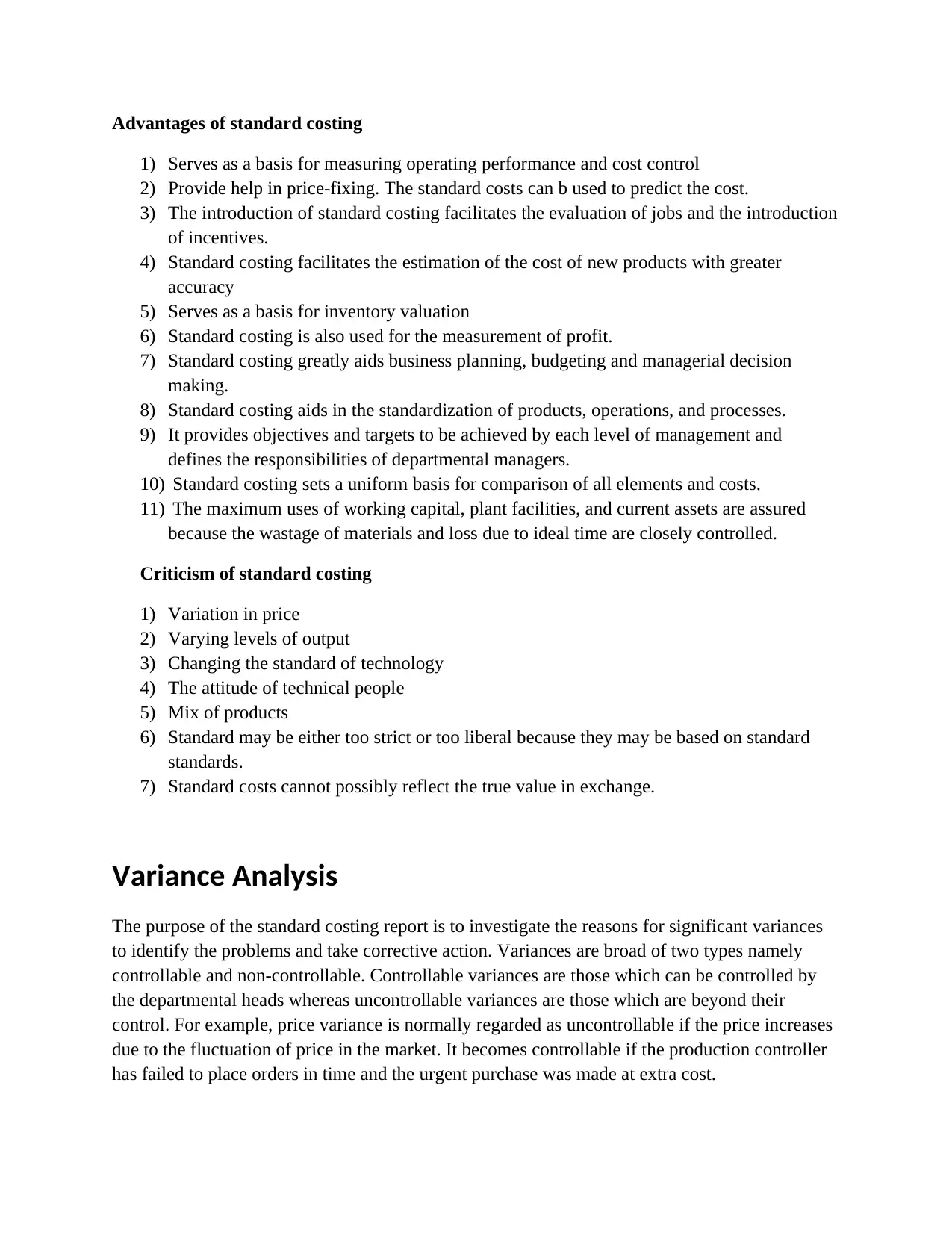
Advantages of standard costing
1) Serves as a basis for measuring operating performance and cost control
2) Provide help in price-fixing. The standard costs can b used to predict the cost.
3) The introduction of standard costing facilitates the evaluation of jobs and the introduction
of incentives.
4) Standard costing facilitates the estimation of the cost of new products with greater
accuracy
5) Serves as a basis for inventory valuation
6) Standard costing is also used for the measurement of profit.
7) Standard costing greatly aids business planning, budgeting and managerial decision
making.
8) Standard costing aids in the standardization of products, operations, and processes.
9) It provides objectives and targets to be achieved by each level of management and
defines the responsibilities of departmental managers.
10) Standard costing sets a uniform basis for comparison of all elements and costs.
11) The maximum uses of working capital, plant facilities, and current assets are assured
because the wastage of materials and loss due to ideal time are closely controlled.
Criticism of standard costing
1) Variation in price
2) Varying levels of output
3) Changing the standard of technology
4) The attitude of technical people
5) Mix of products
6) Standard may be either too strict or too liberal because they may be based on standard
standards.
7) Standard costs cannot possibly reflect the true value in exchange.
Variance Analysis
The purpose of the standard costing report is to investigate the reasons for significant variances
to identify the problems and take corrective action. Variances are broad of two types namely
controllable and non-controllable. Controllable variances are those which can be controlled by
the departmental heads whereas uncontrollable variances are those which are beyond their
control. For example, price variance is normally regarded as uncontrollable if the price increases
due to the fluctuation of price in the market. It becomes controllable if the production controller
has failed to place orders in time and the urgent purchase was made at extra cost.
1) Serves as a basis for measuring operating performance and cost control
2) Provide help in price-fixing. The standard costs can b used to predict the cost.
3) The introduction of standard costing facilitates the evaluation of jobs and the introduction
of incentives.
4) Standard costing facilitates the estimation of the cost of new products with greater
accuracy
5) Serves as a basis for inventory valuation
6) Standard costing is also used for the measurement of profit.
7) Standard costing greatly aids business planning, budgeting and managerial decision
making.
8) Standard costing aids in the standardization of products, operations, and processes.
9) It provides objectives and targets to be achieved by each level of management and
defines the responsibilities of departmental managers.
10) Standard costing sets a uniform basis for comparison of all elements and costs.
11) The maximum uses of working capital, plant facilities, and current assets are assured
because the wastage of materials and loss due to ideal time are closely controlled.
Criticism of standard costing
1) Variation in price
2) Varying levels of output
3) Changing the standard of technology
4) The attitude of technical people
5) Mix of products
6) Standard may be either too strict or too liberal because they may be based on standard
standards.
7) Standard costs cannot possibly reflect the true value in exchange.
Variance Analysis
The purpose of the standard costing report is to investigate the reasons for significant variances
to identify the problems and take corrective action. Variances are broad of two types namely
controllable and non-controllable. Controllable variances are those which can be controlled by
the departmental heads whereas uncontrollable variances are those which are beyond their
control. For example, price variance is normally regarded as uncontrollable if the price increases
due to the fluctuation of price in the market. It becomes controllable if the production controller
has failed to place orders in time and the urgent purchase was made at extra cost.

Appropriate verification of standard cost per unit is based on different methods and they are
discussed below:
Material variance – 1) Material usage variance
2) Material price variance
Labor variance – 1) Labor efficiency variance
2) Labor rate variance
Overhead- 1) Overhead fixed price variance
2) Overhead variable cost variance
Variances may be broadly classified under the following heads according to the main type of
cost. Variance with two types of cost variance analysis and sales variance analysis.
Cost Variance Analysis: Cost variance shows the deviation between standards for the actual
cost output and total actual cost for the actual quantity of output produced. This cost variance
analysis included
Direct material variance
Direct labor variance
Overhead variance
Direct Material: The two basic variance arising during material consumption are direct material
usage and direct material price variances. The former arises because of variation in the quantity
of material consumed when compared with what should have been consumed as per the
established standards and the later because of differences between the planned and the actual
material prices paid to the suppliers.
Direct labor: similar to material variance, labor efficiency measures the efficiency and rate of
labor by identifying the difference between the actual hours worked and the hours which should
have been worked as per the established standards.
Overheads: Normally for several types of overhead expenses either a single recovery rate or
two recovery rates, one representing fixed cost and the other representing variable overheads.
The recovery of the fixed components of the estimated overhead depends upon capacity
utilization. In case the company produces less than the projected utilization it shall not be able to
recover all the budgeted fixed overhead. The unrecovered portion is known as the production
volume variance. The other variation is because of variation in actual spending when compared
to both estimated fixed overhead and estimated variable overhead, this variance is called as
overhead expense variance.
discussed below:
Material variance – 1) Material usage variance
2) Material price variance
Labor variance – 1) Labor efficiency variance
2) Labor rate variance
Overhead- 1) Overhead fixed price variance
2) Overhead variable cost variance
Variances may be broadly classified under the following heads according to the main type of
cost. Variance with two types of cost variance analysis and sales variance analysis.
Cost Variance Analysis: Cost variance shows the deviation between standards for the actual
cost output and total actual cost for the actual quantity of output produced. This cost variance
analysis included
Direct material variance
Direct labor variance
Overhead variance
Direct Material: The two basic variance arising during material consumption are direct material
usage and direct material price variances. The former arises because of variation in the quantity
of material consumed when compared with what should have been consumed as per the
established standards and the later because of differences between the planned and the actual
material prices paid to the suppliers.
Direct labor: similar to material variance, labor efficiency measures the efficiency and rate of
labor by identifying the difference between the actual hours worked and the hours which should
have been worked as per the established standards.
Overheads: Normally for several types of overhead expenses either a single recovery rate or
two recovery rates, one representing fixed cost and the other representing variable overheads.
The recovery of the fixed components of the estimated overhead depends upon capacity
utilization. In case the company produces less than the projected utilization it shall not be able to
recover all the budgeted fixed overhead. The unrecovered portion is known as the production
volume variance. The other variation is because of variation in actual spending when compared
to both estimated fixed overhead and estimated variable overhead, this variance is called as
overhead expense variance.
⊘ This is a preview!⊘
Do you want full access?
Subscribe today to unlock all pages.

Trusted by 1+ million students worldwide
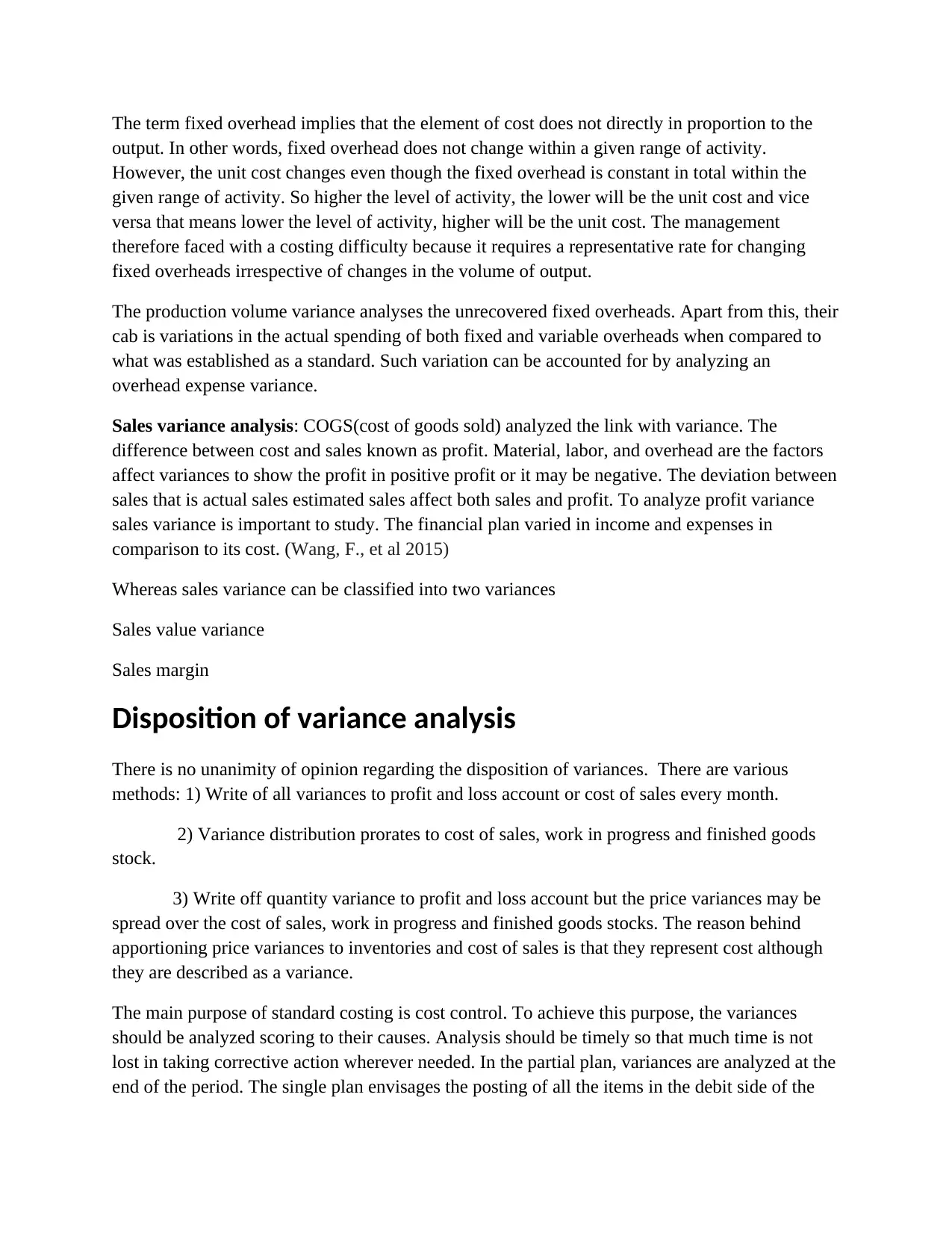
The term fixed overhead implies that the element of cost does not directly in proportion to the
output. In other words, fixed overhead does not change within a given range of activity.
However, the unit cost changes even though the fixed overhead is constant in total within the
given range of activity. So higher the level of activity, the lower will be the unit cost and vice
versa that means lower the level of activity, higher will be the unit cost. The management
therefore faced with a costing difficulty because it requires a representative rate for changing
fixed overheads irrespective of changes in the volume of output.
The production volume variance analyses the unrecovered fixed overheads. Apart from this, their
cab is variations in the actual spending of both fixed and variable overheads when compared to
what was established as a standard. Such variation can be accounted for by analyzing an
overhead expense variance.
Sales variance analysis: COGS(cost of goods sold) analyzed the link with variance. The
difference between cost and sales known as profit. Material, labor, and overhead are the factors
affect variances to show the profit in positive profit or it may be negative. The deviation between
sales that is actual sales estimated sales affect both sales and profit. To analyze profit variance
sales variance is important to study. The financial plan varied in income and expenses in
comparison to its cost. (Wang, F., et al 2015)
Whereas sales variance can be classified into two variances
Sales value variance
Sales margin
Disposition of variance analysis
There is no unanimity of opinion regarding the disposition of variances. There are various
methods: 1) Write of all variances to profit and loss account or cost of sales every month.
2) Variance distribution prorates to cost of sales, work in progress and finished goods
stock.
3) Write off quantity variance to profit and loss account but the price variances may be
spread over the cost of sales, work in progress and finished goods stocks. The reason behind
apportioning price variances to inventories and cost of sales is that they represent cost although
they are described as a variance.
The main purpose of standard costing is cost control. To achieve this purpose, the variances
should be analyzed scoring to their causes. Analysis should be timely so that much time is not
lost in taking corrective action wherever needed. In the partial plan, variances are analyzed at the
end of the period. The single plan envisages the posting of all the items in the debit side of the
output. In other words, fixed overhead does not change within a given range of activity.
However, the unit cost changes even though the fixed overhead is constant in total within the
given range of activity. So higher the level of activity, the lower will be the unit cost and vice
versa that means lower the level of activity, higher will be the unit cost. The management
therefore faced with a costing difficulty because it requires a representative rate for changing
fixed overheads irrespective of changes in the volume of output.
The production volume variance analyses the unrecovered fixed overheads. Apart from this, their
cab is variations in the actual spending of both fixed and variable overheads when compared to
what was established as a standard. Such variation can be accounted for by analyzing an
overhead expense variance.
Sales variance analysis: COGS(cost of goods sold) analyzed the link with variance. The
difference between cost and sales known as profit. Material, labor, and overhead are the factors
affect variances to show the profit in positive profit or it may be negative. The deviation between
sales that is actual sales estimated sales affect both sales and profit. To analyze profit variance
sales variance is important to study. The financial plan varied in income and expenses in
comparison to its cost. (Wang, F., et al 2015)
Whereas sales variance can be classified into two variances
Sales value variance
Sales margin
Disposition of variance analysis
There is no unanimity of opinion regarding the disposition of variances. There are various
methods: 1) Write of all variances to profit and loss account or cost of sales every month.
2) Variance distribution prorates to cost of sales, work in progress and finished goods
stock.
3) Write off quantity variance to profit and loss account but the price variances may be
spread over the cost of sales, work in progress and finished goods stocks. The reason behind
apportioning price variances to inventories and cost of sales is that they represent cost although
they are described as a variance.
The main purpose of standard costing is cost control. To achieve this purpose, the variances
should be analyzed scoring to their causes. Analysis should be timely so that much time is not
lost in taking corrective action wherever needed. In the partial plan, variances are analyzed at the
end of the period. The single plan envisages the posting of all the items in the debit side of the
Paraphrase This Document
Need a fresh take? Get an instant paraphrase of this document with our AI Paraphraser

work – in - progress account at the standard costing leaving the credit side to represent the
standard cost of finished products and work in progress. This system enables the ascertainment
of variances as and when the transaction is posted of a work-in-progress account.
The partial plan uses current standards in which the inventory will be valued at the current
standard figure. Under this method, the work – in - progress account is charged at the actual cost
of production for the month and is credited with the standard cost of the month's production of
the finished product. The closing balance of work – in – progress is also shown at standard for
the month. The analysis of the variance is done after the end of the month. This method is simple
in operation because variance is analyzed after the end of the month but may present difficulties
in the firm make the variety of products... (Ray, P., 2016)
.
Conclusion
The summary of variance analysis summarized the differences in the financial status of the
budget in an organization from standard costing standards. The variance shows the budgeted cost
and actual costs difference cover the price or the quality aspect. Favorable variance and
unfavorable variance determine the output and input quantity significance that means higher the
level of activity, the lower will be the unit cost and vice versa that means lower the level of
activity, higher will be the unit cost.
standard cost of finished products and work in progress. This system enables the ascertainment
of variances as and when the transaction is posted of a work-in-progress account.
The partial plan uses current standards in which the inventory will be valued at the current
standard figure. Under this method, the work – in - progress account is charged at the actual cost
of production for the month and is credited with the standard cost of the month's production of
the finished product. The closing balance of work – in – progress is also shown at standard for
the month. The analysis of the variance is done after the end of the month. This method is simple
in operation because variance is analyzed after the end of the month but may present difficulties
in the firm make the variety of products... (Ray, P., 2016)
.
Conclusion
The summary of variance analysis summarized the differences in the financial status of the
budget in an organization from standard costing standards. The variance shows the budgeted cost
and actual costs difference cover the price or the quality aspect. Favorable variance and
unfavorable variance determine the output and input quantity significance that means higher the
level of activity, the lower will be the unit cost and vice versa that means lower the level of
activity, higher will be the unit cost.
1 out of 11
Related Documents
Your All-in-One AI-Powered Toolkit for Academic Success.
+13062052269
info@desklib.com
Available 24*7 on WhatsApp / Email
![[object Object]](/_next/static/media/star-bottom.7253800d.svg)
Unlock your academic potential
Copyright © 2020–2025 A2Z Services. All Rights Reserved. Developed and managed by ZUCOL.





